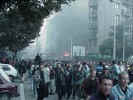Kingdom of Serbia
 Serbian Princely House of
Karadjordjevic
Serbian Princely House of
Karadjordjevic  Kingdom of Serbia
Kingdom of Serbia
In 1813 the Turks returned to Belgrade and Karadjordje fled to Austria. His son,
Prince Aleksandar, returned to rule Serbia in 1842 but was deposed in 1858.
In 1903 Parliament requested that Prince Petar Karadjordjevic - grandson of Black
George - came to the throne. King Petar I brought democracy and leadership to Serbia. He
had John Stuart Mills' essay "On Liberty" translated into Serbian.
While the Balkan Wars in 1912 and 1913 resulted in the expansion of Serbia, the
annexation by Austria of Bosnia-Herzegovina enraged both neighboring Serbia and the people
of Croatia. Nationalist aspirations for independence from Austria finally led to the
assassination of Austrian Archduke Franz Ferdinand in Sarajevo in 1914 and within days the
First World War had begun.
Post World War I
Before the end of the War in 1918, representatives of the three peoples proclaimed
by mutual consent a new "Kingdom of the Serbs, Croats and Slovenes" under the
Crown of King Petar I. He died three years later.
King Aleksandar I, who had acted as Regent for his ailing father since 1914, had
earned national fame as a soldier in the Balkan Wars and the First World War. In 1922 he
married Princess Marija of Romania. They had three sons: Crown Prince Petar, Prince
Tomislav and Prince Andrej.
The new kingdom faced many threats. Neighboring states coveted many countries
territories and internal rivalries between the Serbs and Croats increased tensions still
further. By 1929 it was clear the King had no option but to impose a Royal dictatorship.
However, he did so reluctantly and promised to restore democracy to the newly renamed
Kingdom of Yugoslavia once unity had been achieved and bureaucratic corruption expunged.
In 1934 he was assassinated in Marseilles by a Macedonian terrorist working with Croatian
extremists with Hungarian and Italian support. The French Foreign Minister, Louis Barthou,
also died in the attack.
King Aleksandar's son, Crown Prince Petar, was only 11 years old at the time of
his death when he became King. Three Regents were appointed. His great-uncle Prince Pavle
- married to Princess Olga of the Hellenes (Greece) - became the Prince Regent.
The Second World War - The communist abolition of the Monarchy
By 1941, all but one of Yugoslavs neighbors were under Nazi domination or
influence. Despite Prince Pavle's pro-British sentiments, to avoid bloodshed he felt
obliged to sign a pact with Germany and Italy. Shortly afterwards on 27th March, 1941
Prince Pavle was unseated in a coup and the young King Petar II was declared of age.
Within a week, Germany, Bulgaria, Hungary and Italy invaded Yugoslavia and the
government was forced to surrender. King Peter II, with the Yugoslav Government, made his
way via Athens, Jerusalem and Cairo to London where he joined numerous other governments
in exile from Nazi occupied Europe.
Yugoslavia was divided to satisfy Italian, Bulgarian, Hungarian and German demands
and a puppet Croat state proclaimed. Despite the collapse of the Yugoslavian army, two
rival resistance groups to the occupying forces eventually formed. The first was the
Royalist Chetniks, led by the loyalist General Draza Mihailovic, Minister for Defense in
the exile government. The other was the revolutionary Partisans led by the communist Josip
Broz - known to the world later as Tito. A bitter civil war followed.
The Allies, having initially supported Mihailovic, then threw their support behind
Tito. The Partisans entered Belgrade in 1944 in the wake of Soviet tank brigades and
established a Communist Government.
In November 1945 the monarchy was illegally abolished without a referendum and
Yugoslavia remained a totalitarian single party state under the League of Communists for
more than four decades. King Petar II never abdicated.




